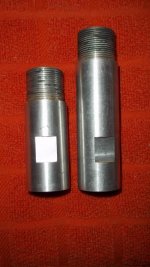I think that the discussion of tuners has largely ignored a couple of things. Rimfire tuners on unlimited rifles(no weight limit) may be configured so as to move a node to the muzzle because of a lack of rifle weight limit, so that balance can be maintained no matter what the tuner weighs, or how forward the weight is placed. Also, the low pressure and level of disturbance of a rimfire rifle as it is fired allows the use of slimmer (then for CF applications) that reduce weight needed to accomplish the desired node placement. It may be that the weight limits of 1,000 yard rifles allow tuners of sufficient weight to move nodes to muzzles, even with the larger diameter barrels that seem to be required. This is speculation on my part, BUT with the weight limits that are in place in the short range classes, particularly sporter and light varmint, the minimum barrel diameters that are consistent with good accuracy. and the need to have good rifle balance, I seriously doubt that a configuration can be developed that places the node at the muzzle. What this means is that discussions about how tuners for these applications work and should be adjusted need to recognize this difference. Yes, this is only one shooter's OPINION, I make no claim of proof, but I have seen nothing that disproves it, and quite a bit that seems to be consistent with it. Claims that CF tuners (for the specified applications) work like rimfire tuners seems to me to be incorrect, and have not. to my knowledge been proven by the construction of any rifle that proves their correctness, again, for the specified application. I bring this up because this thread is about how to adjust a tuner that was developed and is used for 10,5#, short range CF rifles, not rimfire, or thousand yard rifles. If we would specify the application at the beginning of a discussion (as was the case for this thread) and save long range, and rimfire "truths" for threads about those applications, I think that there would be less heat created, and more light shed.


